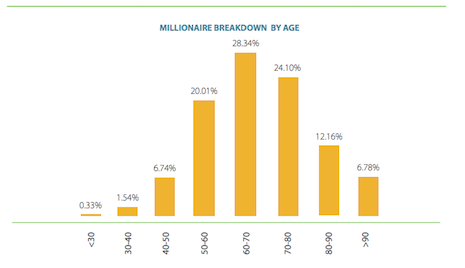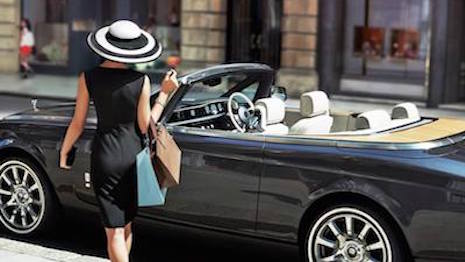Each of the 16 million millionaires in the United States right now is a powerful influencer with whom brands can engage.
While only making up a small portion of the total U.S. consumer population, millionaires are incredibly valuable for luxury brands, not just for their purchasing power but for the ways they influence others to make purchases. A report from WealthEngine shows that millionaires today are more diverse than they ever have been before.
Diversification
Since 1985, the number of millionaires in the U.S. has grown exponentially and is expected to continue into the future.
What this has done is create a fragmented base of millionaire consumers in the country, spanning across age, race, gender and national origin.
In 1985, when there were only a few hundred thousand millionaires and they were all of a similar demographic, brands that targeted them had relatively little work to do.

California has the most millionaires. Image credit: WealthEngine
Now, millionaires are almost as diverse as any other group of consumers, meaning that brands have to adjust their strategies to adapt to a wider variety of high-net-worth customers.
The average age of millionaires still skews quite old, with 60-70 being the most common age, but younger people are increasingly achieving millionaire status at a rate that previous generations had never known.
This has had some significant effects, such as the fact that younger consumers are far more likely to be interested in experiences over things. The reverse is true for older generations.
This shift in age demographics means that luxury brands have to be aware of what they are selling and to which section of the millionaire demographic in the future.
Common threads
Despite this fragmentation of the millionaire class, there are still a few commonalities and safe bets that marketers can make. For example, certain areas of the country have higher concentrations of millionaires.
In a state-by-state rankings, Maryland retained its first place position for the sixth year, with 7.55 percent of its population identified as millionaires.
The states that made the top 10—Connecticut, New Jersey, Hawaii, Alaska, Massachusetts, New Hampshire, Virginia, District of Columbia and Delaware—remained consistent from 2015, with only a couple of moves up or down one spot (see story).

Millionaire age is diversifying. Image credit: WealthEngine
When trying to reach an affluent audience, the channels that marketers use to disseminate their message often reach a greater portion of mass consumers than the wealthy, according to a new report by Shullman Research Center.
While the general population of adults is most apt to remember seeing placements on television, those with at least $1 million in assets most recollect ads served on Facebook. Aside from divides among millionaires and non-millionaires in media consumption and engagement, different generations of affluent consumers are more reachable on different advertising platforms (see story).
With these commonalities, plus a healthy dose of data analytics to determine other demographic information, luxury brands should be able to adjust to the diversification of millionaires in the U.S.
{"ct":"uamL0TQ3A2y3U4GSTjz+qdQQUcJusDNgH7A4RYnqwEOI5kITP6byqQnv3MECgGOIeddHdi+ohyIf103L8l1b1px1wmEEfTbZ71\/hyaEac7o9\/PCj030PsO+idu5MMdS9U9bHlM3XYDEvdSdCHh53TWIqxZUVpXojWOUNnEuJxDiZers9fHOKsg2gJgkhcdH7omFvsZXxmYtNjvZuFh4seaZnkQV8SSeeDqUMm18ltR+QiUvx6T4b7j+wFu2jGbfmctm0ZyuG+o+\/h0GaS7FAUl5I\/N2WHLSW6KBD3jpbe9yutFBUrnaBnr5fuFWtHQbwr9SPlCuXRCmWdRb3zUrIrDKHHPMYS5UD3so2XDx6s\/8xSvO46zmTc0ZNzQmYukKGzIMN7BBHcSGu3K0e1GdwPtVwuzmnquYdVyBOcZI60BK+wMSoxJzGKaLDN\/Ti9GIY8Rtbe5UFNjU36nZVvv4XQPxecav3GQY0fpObgwV+AlJdmh1GQ784Ijy58b8LYSUaWB6DsxYm74SCBaxYv71gvkjZngcndXUK9WvoS2aGpuwnO5c5THoR2q1vxS86i7YJhp4N0vp3omjpy\/unJLeueVjXHX86d7oVOeHoQVlZuj1d4DSqGR4bmCDCKGwnss9YwNJnCwFp+b4ltgwzzX57HTrt4M09R5ESq\/eDEqDK3zo8H4qtDrgMLL32odIVAasKR\/Hj3fmDQa+7mI\/en\/Cmqo7hzjTpWAl2tftzmPT6ntfgs370GwxebwhRf3r8tRBdtSLuGqZNhlncOnPJ1QseSaHtgh7cKJCj1XGfpzCAfAKKWp223H\/qSkivjVyr6vhM+m0LY7ELn0oxN1OcoWqwcpIs8l3B+xI6zICvsCOhh6330Q6l24RMTfK9Eeju6Nq\/lCTaJ10XMmA7TXwifw0Ocj90j6CGmGC9zrXFCz8xwVMqVE2MKNw5aDg2etgRX225xF15OeR8yiB0mNz9q6xyUApQZeBnELeHk8Jj2n3ok7ELN8ViJKOThZtfm2U2X6jXT9NYjp8EhAcaZpsFqK5FDTUo9OkDRbD4\/YPl3I4Ui5c3WdRZJahlfYs9sfnUsQmczdxqTOcvWageJFuwizQ038RuDpK3RXq5YZzspMSw5oEQ5\/Jk50QH\/ZL9AM56fG517y\/8SY5Ils7\/6XcaNoPZEfNewVgJBQK490KFtpGlNsY39SYMi+DKB0qfiBQpm+Ue7syDHOG\/9vGunXHNs1NBrBOjWl3CBfjeyV9PVRYqB7C6QjKfSjsFHP7bmFdQtCKHRQxKc298y3Qjnhec0GQH5n3Ltp071+BGvO6FJdHHcb+Kd\/odIcJgh65pPCdWS1+hH9YosHPdxqBQFYp4PU6jd3rW4erGTHPNT4JWf6GrGOSrp5lmQ0t2mHzZqz3H7NnNeMy4p8y13ltffzLNQo2E5jHMu8ydcKX4PtvofJ5zkICI+Xy3is6LzxsRCMkw1xabf94yTNVgIQkJMeU0byGcdd+q5sHqIBngEJCnmKVewx+yDOhqGwEPzyS19IhNykFAofl9bzRmr50jbTzFxXaiuZL3TkaieAOHX4Az8ESm6xQ\/ltg\/P9i0WzNUocJ0AfFAo+Q4bHjQ9fVlay5H\/tX1P1c5h3UNsFepAXl9L8TeF55LzDP9Jgbtz5w+KN6asDfRECCLFIZf9y2tr0+IKP+w2MYl\/XNe9deACRa2t3JTX87PhZB\/NB\/ZERcpPQEnMrHqUHVH8V71YDf+wkEc2D9M2M9fSqsat7xJlXcBNt8QWRe1g0NDdcKW\/aMOhAcz63b0Ecs73mBsriZ4r8J8zSzgz7kHXVHRefVfMINkQmXX50ewjB1gl9HLfmjdb+pC5BFX4bOvRkNQX3DFA\/yNN3mVvb+TNKTeNvGBWyRbWUpUI0so+hotrE2HXuDhjl+Z+L2pVKnlPZ5\/U74mDNoWODrTK5owZa04Ku1ryXgufMFL7N53VCPV8sFOeTyM5L3Xo0Qg2ONplSmAodTaDKJpMiWB9qMvQE1fqc3D1wlIzXHdNdB2Q9gIyjCe7kpoP5kB4X4ykHCkvryfjn8PdRdyuCeNT0F18rQ7F1bXAbkhQq7OTzlNqbbS5NAKnTPOytAFJ2w5WqcY10WeJpuARIMfWxzUeW8vgYm5nv65PvUdJ4qtexvwF\/Ey2xZmXopAEqK3QM+NtVx4XcBjY0L9bRDTerY4XQpz67ltT3S4XY+ook1NAB9Z7gpxQ9cnUsZYchOLo05SMxXyfWDOR6yxVEofUiyrAXxW6o66ju0l+o4nN5IJwoVfFZZQq1Edhr3d6sira8vPsn6r2GgEegYWSVvyMIU0dR9XmZDpcJBUXay\/sNF7mtAAYEu7ZulwuApw\/PDYACTA76SV\/zq7ky61PHWF8+Id+WZCk1DGEq81M81pAHCKUSyOLnwLehSnt5warrlAD\/+PdQGSP4ZLA3l2y0NETu3X+YwChbzwKTMFI4pRqiHjWGriQUT8fba4AM8YnZ7uPYJNoML7D+qBzoouyTkTuJlbXX5axL+ziQToRnUIn0oZ8YVF7gKrZatpEt\/gRl7SeGfNxjzzQYxto2iNQipxj1lmz5wweYOBFARA9USjLXbjjskPb7k1KwIrYo\/duAOsVvX00e1UngOy1sN0gjiLw36e4uflEBUFLBLZgNZoRKeCTe3T29KqLyq4zS3Er2ekjxORL9t3hJLL2wvWIr+S2H8cPkpXkMUva6qWvmFGrrkir\/S2Ji9XezaYrOckVZcD4cgV2GIZYNlgY4l6wxRzIdl5tmhXc\/\/21oRJOy8ykGR9gCf5Jjlao57DcYVzNg2aMZAyJY5hHosyUEgajKIjOc0ksClSvDAAxLw2vyCGcO\/+PrmcipwkJGo\/yuJo9dwBRpSwftCuH\/KT\/ME0xDqfCo6fk7c\/QTYowbgvAeZyKlTPvia3ZmJVLm5ZRPZNbhFBrDAWlkHpvbX\/tjRJ0GBWkYxVgyVWiioEb1zf5HkVjQR29yWSLKYbULEVvNs6EApMYQlDv9ueR9QH3EvPT+DaWFARrlp7viQhkorX5RvfblglvIxnPqp3XluV7ejjeOgJQ+qb63dLVD+fgbZF37kVIYPjxt0aTV\/zIfKsw622GvX5FEFPf0v9nbED3tceqw0195kW7s9hEFF\/\/IuaLjx7gpqr3bXS5oqsQv8EXYrvlU1DliwnSR655X4oqBcdh7Vn3o6RCxodnm4LuHZRo2nOwNQDOZhkro5Cm6bz5dIz6tQnrxN87NxGsFNhgSl9EjJ+U\/AsUdg9i0BRnmT3bJc3V4i\/FynCNQSLD9piMES8L7y2lhxDH\/ht2ByDZ7apX6Vp39GBLcrbWTdVPhtK8VPuwacycnSyGE8xoduT6afUxilTPJe0D9atpTbfHTPyKJDvhffzIC429\/mGk7vim+dHjLjDM5aveJm1AVwYDBbGHKIVH\/qz0zku7jCzClR4JoamAsO41GfORnC4vW4q6Zarsa3kq+\/G6\/F3W89EymjhqhWIwZHrffeP5JRIoCP5I8Qquz5iyFyOZIm53oWoDKWJETtcGzSbcfWL5zvsrQljCKREpJoJDpbjafDjtpFICIPGr2knYcH+jVGzUZgfbXfdgVzaMdDGF7tWrg6vSm1YY3arA624eioIAExfwVUdbkI9VCoat4Vjby88aNEJKOKrXBv1oWreQ2nmgXtnRMTHS+q56xd6FGhZ8C\/rDqHfLc6rgdiHLGZDC8DqWM95J3PoJ2cA9rL8QC0IPesurY7dGZwoIgqTGmgRNNQiLjV2ESWIb5Ln6fdy6HK\/LVVMq+dcGldhY+NhVK861Bl3KlpEVX6lMiuqPv49\/IBh78Fr8w2YPVhnE\/cGyGCXwYN5wmv0yEBA9LTl0Z4j0VgbLiwSUo9uC21JNP61+\/BG0h6SfO3y7PXoHV3jyKrqfu+vNH7KCQazDfUdo9NwuEAvgGwGkr3mEWKkWtx7Y+H1mPBRYspMolEm56ZYPrqVOrFpI9fyGHsZs0rfdrdHrf1m5sVYqhAKIHqFNwOmcglWoTBGGhuQo8gMds0xsWFC\/ZplzfGVd21kpT7FXyNZcxfzhzfhZlCgzMSZ\/9apYVkdwh\/QgPZAyusvjg0TNXbBsxr4+2TE44dtyAfSJ9krjXvI7e6NxH1IrGlI1dBVhujbLGRKtnjxZa9h\/pB3asuqOgEiAGA8gra5lEEMfJiAOe\/ogjyqQ5BphOWizdwKg1Xf7h69GLPzMyfeC9Ne29BMdtcDWPY3kRnwBgYoIk9ltWXF6KaAoKXzc\/sKiHHY76P6JID4izruFdpeNAJOjv+6CTbi8T4+RcJT19ODRkDoBwEHn0XMJ+AereMwluQCYZ\/94nyFZ8unRgYoQF75L17oOgWz5d27ki6L5lqIcZCCc\/GVq3ACm4xd\/7CNJ3y8RekdgBvLDEfgx9NKkAHUDQeucL2i1dbuij+1hxtMA9gcdTvQac+4PvtsG26Y58uynhCfaCd8R2bxFwbiVZJV4ZPfJ2xhWPw83pktjI24qbTnvvzkDCUf8NoSr3PGWmRpS4ExVD9oMFT1uK7EKRagOZMFbV99ZYxDTIGbzA07Te\/ESrmq9eRFzRORbYg3xTTosp6mhtWvgCGE0H82Cl\/+H5m6mbzEPIqZCyL4EaVap7O++3ycNiXtuWltb+B6WViVPeiBoFFxSuAmz+lrGz+wzu2qmlde0bIi2sVqI1oJviTRDdUZ5PFXTKfKzAOC6epZKwf\/\/Uvf9G4PQfLagwT9+zjqAjX7Ik\/WQomzw5cpp3zLJQBpDha6CZotk7Z3sLlgb0ko6ODMeEjqBPORGBrDEUXXEb5GW+jB5plCk6X1L6juCT+aYcDhA+QZ7OOCBm2sbZMPb356CCj4ew79VqG0aH00ejqgvzjjiCPjdFyAX2tk\/vapzyHqL+PQIFCtSqcOiuViiIbc7g\/9erVfkjUiq1JkMYmSkbqHRj+Y0Gkg+NWI+\/JuGmc7H5bK+gV7rQGp1kZR\/LeeePn3dR3jUD27dS3M+3gfKmxAq1HrGyokNMEuzKzp1Rj5mEfnyedCcVcQhq9RblJAAbOqmIbNtSVZy21jwsdxvOC0k\/LYG9DshlbG4b+xvsGigpf1xb6p3VOHaWJqFRWdxin8bC28xKiPQIoYkhZEJnjo7qsvftX\/5mmXAgVdDtGjCf3VREfj7gCz4dSHAL8d2uQDdrccZWb52SkWRoWppnP0siXMmdLX0n8KYETsFkpaBrWmmCIQwyhOCfCTp7T+jwayQBpnf89mN7pTuTyXhheLMjGZ90MwFOV\/FKUnFyGpaCY+bNlSvf85ywyAu8VQLvUy7XORTsSiJ9yp6HHYPUT8T5XMCN+CJke6y2DaYQD8TUCwCGOxfio2gD8U+U7cGzcZuiEztVZm\/CB\/Z6ezyrpBG9Hc43ndCRxRTubJMMxyuhBxT61S78sau1s4Ru6Qv3NzAjRWtKtc4KLCzE3N99R0LLARbjtsrz2Fg6cAXyDqAwW34zBpEjFxCDXJ\/C27Hx1RgxglPUk7nFjB2mVQXhGsFABozw7yQ48TaT7yaIdOC9AgoRyLqIgw2qqERqyF04xv8hc9B4KuBOruF0kVcdFtlDroCVK7lhCnGHWkG4jKDLO64wRjvk0YoWSLWCEn3m0CeTlX213fFLS\/YcYTXyKtVeSU4NYApoHQQOGnDrdZTvZkdfJD9wCFfQj1fl0V4rqReV\/eXvXG1knWv7oXj+N28iphjMEg0aavSl05MA3jqrXAtUYmL+kOpyKgczt1hHDEvhWuxAhazXfgTeXtq0ObCVImrGGtrWYZ\/vcm5rhS3YgPRm1VpNygvQZ8CBRIMCX9Hr9+hodSb004sbGuGnnTW7xl+maR9AGveEsDNHkVX\/DqMERgmXT\/HdToNMfg3V7iJANUogxF+FWZDHoLvXL7hC1U1hZlWDyxgs8B92n+EBSXf2ZQI5MpO4Ud7iw7U7Y9InWccpHKJptUY\/EK0YqPm43xUW+ph+Hy17FI8DUMShmWtr0=","iv":"646a421dd604a031dcf61a2998561d42","s":"fd2dc4e3d79594d5"}

 There are 16 million millionaires in the country, and each one is a valuable asset for brands. Image credit: WealthEngine. Image source Rolls-Royce
There are 16 million millionaires in the country, and each one is a valuable asset for brands. Image credit: WealthEngine. Image source Rolls-Royce